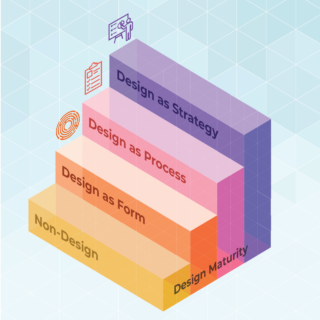Digital Transformation & Design Maturity
by Dr. Erica Thomas
Digital transformation is a priority for many organizations, but few succeed. Also, digital transformation means different things to different people. At Limina, we daily work with organizations on digital transformation and design maturity initiatives.
An interview with Jon Fukuda, Partner, Principal at Limina, discussing the UX building blocks to unlock digital transformation.

Q: At the heart of digital transformation there is a strategy and a methodology. What is the most effective approach?
A: We’ve seen all manner of digital service and product development over nearly two decades, both from digital-first businesses and legacy organizations adapting to tech-centric business models. And the one common thread we’ve noted is that the strength of technology and business innovation is only as powerful as those who operationalize it.
For progressive and transformative models to be sustained, it has to start with people. Combining a human-centered approach with design-thinking, lean UX, and an agile mindset will impact business, service, and product operations to provide better planning and impact measurement on employees, customers, and users. Taking this human-centered approach to planning and rolling out your digital strategy, you can ensure that your systems integration, digital service, and product features are bringing the business and customers along in the journey. Making incremental and intentional steps through the build, measure, and learn loop will stabilize long-term and sustained success in your digital transformation.

“Digital transformation is a priority for many organizations, but few succeed.”
Q: Why does digital transformation often fail?
A: There are many pitfalls along the road to transformation. What we call digital transformation today is an evolution of operational business change management (BPM/BPR) practice. Taking that longer-range look back, you’ll see that there has always been a challenging human component of culture. People can be stubborn and dogmatic and generally say, “this is the way we’ve always done it.” Making changes to processes, in general, is challenging. But with digital transformation, we’re talking about the added complexity of cross-functional and inter-departmental coordination. Coupling this with new technologies and deployment models redefines the scope of a release and how design research and planning impact products, services, and general operations. Think about how amplified the human response to fundamental changes might be, whether within your business or across the customer journey.
Digging deeper to the root brings a change mindset that is open and adaptive for supporting a constant capacity to sense and respond to internal and external impact as more systems integration, data automation, and transactions come online. People need to be set up to adopt a lean/agile mindset for building and deploying products and services. They also need it for collaborating in coordinated loops to listen, respond, and measure as you go. To achieve this, it takes a business-wide degree of coordination and movement. Individual contributors at all levels of the organization should understand their role in continuous learning to support this transformation. It’s more than retooling. You should also consider the impact of training, skills management, and cross-functional coordination. The transitional learning should help build a culture that encourages opportunities to learn, even if that means risk-mitigated failures that are small-scale but valuable for the organization to fail forward. Innovation will seize when people don’t feel safe to step out and try new things, conduct experiments, and trial their way to success. These are the types of things I see when transformations hit a rut.
Q: What is design maturity, and how does it fit into digital transformation?
A: The word “Design” has had an interesting journey in the corporate world. I assume this has a lot to do with its rich history in advertising and marketing, but whatever the reason, there’s been an “otherness” in general. Still, this has been changing over the years. Over the past five years, I’ve seen improved perception and integration of design as a business practice hit an inflection point. The Design Maturity Ladder, popularized by the Danish Design Center, analyzed 4 degrees of design maturity:
- Non-Design or not practicing
- Design as Form or surface and visual presentation only
- Design as Process or design-integrated product and service development, and
- Design Strategy or the practice of design processes to innovate new business models and strategies.
Look at the progression in terms of how it supports digital transformation. You might see how businesses at a level 3 using Design as Process would start to successfully implement technologies, workflows, automation, and general practice management according to a design process (research, ideate, prototype, build, measure, learn, etc.). So building up your capacity for a more deeply integrated and mature research and design practice will level up your transformation game.


Q: How can UX play a role in digital transformation? Or should I wait to think about that once I have a digital foundation and a plan in place?
A: UX, as a practice, manages processes for researching customer/user experiences with products and services. The goal is to drive better solutions and implement designs that resolve friction, increase ease of use, build intuitive experiences, and make those experiences both delightful and desirable where possible. So when it comes to digital transformation, UX practices can help ensure internal business operators, end users, and customer experiences drive ease of adoption and transitions as your business evolves. Utilizing your UX practitioners to stand up lean and agile processes to help manage incremental change can become crucial to unlocking successful digital transformation.
Q: When you say “building blocks” of design maturity, what exactly do you mean? Are the blocks the “how to” steps for success?
A: Within each block, there is a sequence of steps and packages of outcomes, so we didn’t want to understate the complexity of these building blocks by calling them steps. We also firmly believe that a human-centered approach in any organization requires an intentional focus on building a solid foundation in practice and skill. Putting these blocks in place can help to flesh out and build common ground for a human-centered approach to business transformation. In a sense, we tried to package each of the blocks in a lightweight how-to unit, but executing the blocks will take intention and effort. Having the blocks as we’ve put them together should help set the stage and roadmap to implement them. We fully expect each organization to have its flavor and implement them in novel and innovative ways. We hope these can be a good baseline they can adapt and personalize.

Q: Is research a part of the design maturity process? Also, what is generative research?
A: Absolutely. When people initially think or talk about design, they tend to lean toward the look or feel of a thing. In practice, the design of a thing takes into careful consideration the use, utility, context, and user. Who’s it for, why do they need it, what else are they doing when they’re using it, and how can it be best designed to fit that need and context so that it’s a seamless and optimal experience. Design that happens without this foundation is more akin to art than design. Getting to the root of who these people are and gaining insight into their lives will lead us better to integrate our services and products in meaningful ways. Insight management requires a solid capacity for not only research but to allow discovery and experimentation to drive insights that can lead to business, technical, and design innovation.
User research falls into two camps:
- Evaluative Research – or how a thing that exists impacts the lives of its users or customers
- Generative Research – a more open investigation of a user or customer’s life without the thing. Or maybe even some other version of that thing, depending on the nature of the study.
We have found that generative research and its openness can lead to profound insights unlocking innovation opportunities.
“I firmly believe that a human-centered approach in any organization takes an intentional focus on building a solid foundation in practice and skill.”
Q: If I know design is important, but I’m unsure where to start for my organization and cannot build design operations in-house, what should I do?
A: Your question hits on key a theme in two of our building blocks. Human-centered design professionals who can bring a depth of knowledge to support organizations through digital transformation are rare. You can indeed find and hire or train up from within, but we’ve found that this model of transition can be a slow ramp. Finding the best-suited partner can make all the difference as they step in and fill your gaps. Most UX and tech consulting practices have been at this game for the better part of 20+ years. They have established DevOps and DesignOps models that aid in rapid requirements gathering and management, research, design planning, and deployment systems. But not all of them can do this well, and in a way, that enhances your own organization’s capacity to build maturity in its own right. So to help guide your vendor selection and onboarding, we’ve added two building blocks to support you through selection and integration.
Q: I plan to hire a UX vendor soon. What should I consider?
A: I think the three most important aspects to consider are:
- the vendor’s capacity to take a human-centered approach. Do they take the time to grasp the needs of the people vital to your business, from customers to your back offices? Can they demonstrate how this understanding leads to better planning and execution?
- Are they process-oriented? Can they articulate a plan to get from discovery through design planning and execution?
- Finally, do they work in ways that their skills and knowledge are transferable and empowering for your organization’s capacity to build up a UX practice?
These vital characteristics can set the stage for UX maturity and aid your organization in setting the sense and response cadence beyond deploying those skills in a specific project or product release.


Q: Thanks so much, Jon, for your expertise and insight. You’ve shared so many gems of information; how can people learn more?
A: They can watch the on-demand webinar to learn more and download the slides for visuals. Also, I welcome them to connect with me so we can learn together.